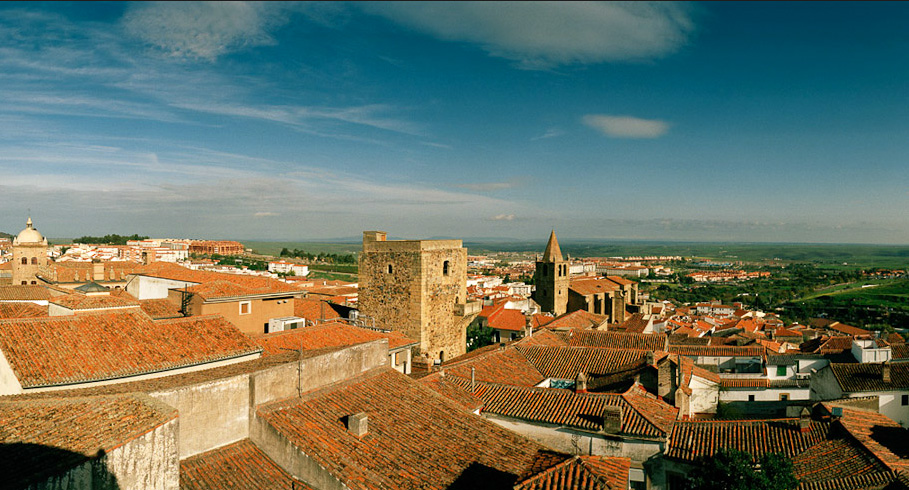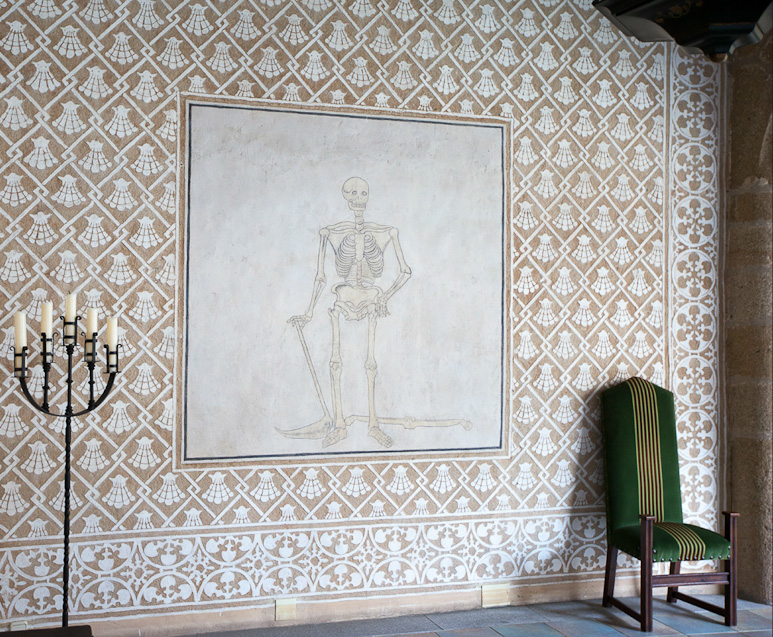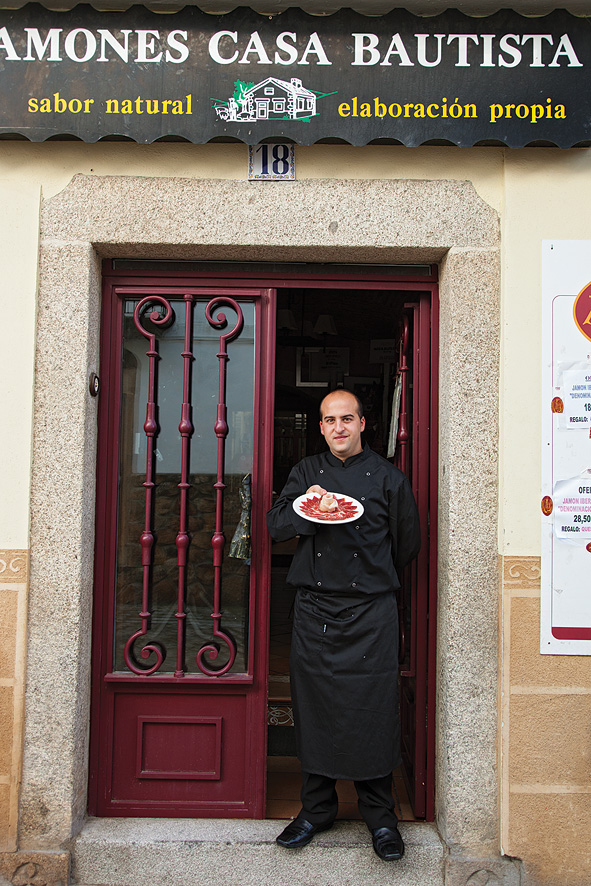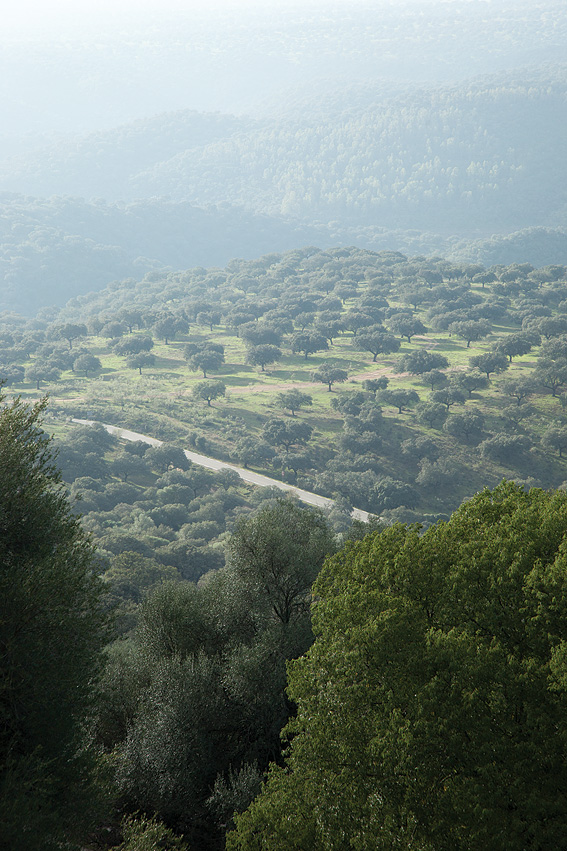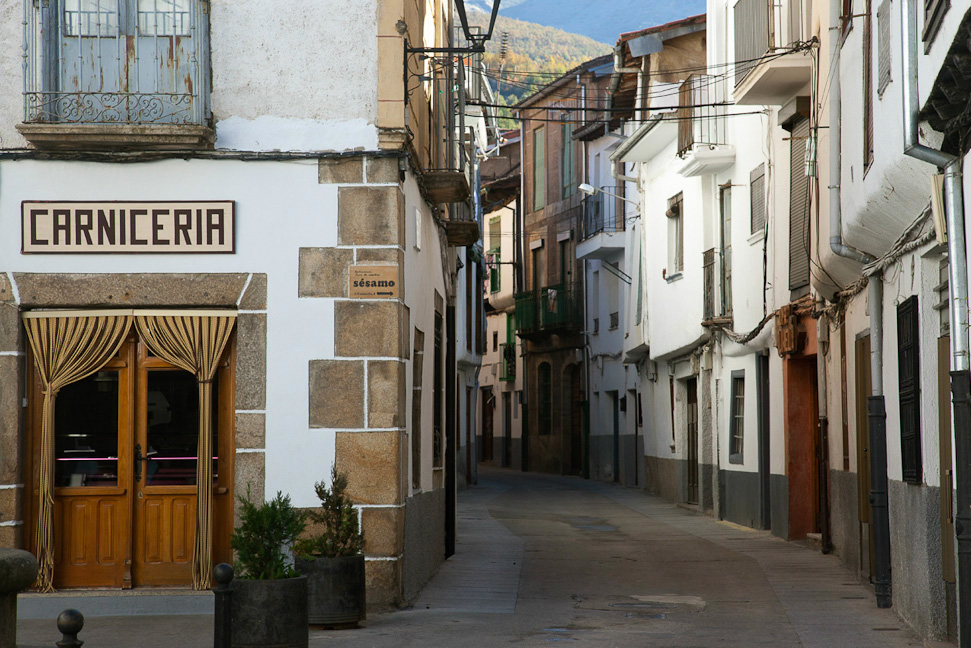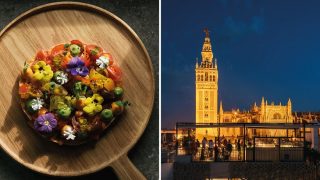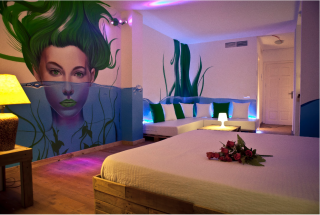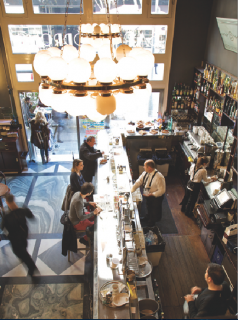Forty kilometers southwest of Hervás, in the heart of the walled city of Plasencia, we wake in a 16th-century Renaissance palace that has been converted into an elegant inn. The owners of the Hotel Palacio Carvajal Girón took care to restore the entryway, salons, and staircases of the original family manor, preserving the building’s cool spaciousness while converting the stables into a bar and an old wine cellar into an indoor pool. Palm fronds rustle in the breeze outside the window of our suite. After rousing myself, I stretch out at the bottom of a deep, square, bubble-filled tub the size of my entire bathroom back home. I feel like Audrey Hepburn in Sabrina.
For lunch we head to Parador de Plasencia. Occupying a 15th-century convent, this is one of Extremadura’s seven paradors, or hotels converted from historical buildings, and surely the most beguiling, with a Renaissance-style cloister and library (now serving as elegant meeting rooms), an open brick bodega (recast as a night club), and a stone staircase that seems an architectural miracle—it was built without columnar support so as not to obstruct the view of the former sacristy, which gleams with Talavera tiles.
On the other side of Plaza San Vicente Ferrer is Las Catedrales, proof that Plasencia has been trying its hand at melding old and new for centuries. The townsfolk started building a Romanesque cathedral in 1189 when Plasencia was declared a Roman Catholic diocese. They added pointed arches to the nave and a roseate window in the 15th century when Gothic architecture was all the rage, partly demolishing the older structure. Later, Renaissance elements were added, resulting in a dazzling pastiche of styles.
Almost as impressive is our dinner that night at Palacio Carvajal Girón. Served in a glass-covered courtyard, the degustation menu begins with a thin stream of pumpkin soup poured slowly from a porcelain pitcher over tender slices of octopus, diced apple, and croutons. Then our server brings us tenderly grilled squid in an anise-infused bouillon, followed by a plump diver scallop on a bed of scrumptious boletus mushrooms, foraged just hours earlier. Next up is long-simmered and buttery oxtail with celery root, and then an assortment of Extremeño cheeses, chocolate, and hazelnuts. By the end, I’m swimming in flavors, and feeling as stuffed as one of the region’s acorn-fattened hogs.
We continue south the next day to Cáceres, a city built by the Moors on a Roman foundation and rebuilt by Christians after the Muslims were defeated. Its UNESCO-listed old quarter is still enclosed by crenellated Moorish ramparts. Of the 30 towers that once protected the walls, only a dozen remain.
In the cobbled streets, an annual fair celebrating Cáceres’s diverse cultural heritage is in full swing. Locals and visitors, some dressed in medieval costumes, jostle to the sound of drums and tambourines; whole pigs sizzle and pop as they roast on cruciform spits; sausages, chickens, hams, and ribs stud grills the size of wagon wheels, cooking to a coppery brown above enormous kettledrum fires. In a booth set up by a North African calligrapher, I have our names written in a beautiful hand in Arabic. At another stall I spritz myself with oil-based perfumes redolent of lavender and cedar. We sample bits of meats and cheeses, and homemade mead. I continually find, lose, and find my husband as we weave through torchlit passages festooned with flags and pennons.
Our room at Hotel Casa Don Fernando overlooks Cáceres’s main square, Plaza Mayor, and at sunrise the next morning, I watch the old town blush with dawn. Later, we climb to the top of the 12th-century Torre de Bujaco for a bird’s-eye view of the city and its ubiquitous stork nests, which sprout from poles, towers, and chimneys. It’s a completely different world within the pristine white walls of Centro de Artes Visuales Fundación Helga de Alvear, where the collection runs to more than 2,500 contemporary works by Spanish and international artists. Some of it is quite challenging, like an installation titled My Madinah: Pupp Tent/Puss Tent by the late California sculptor Jason Rhoades, which depicts a tent-shaped form covered with dozens of dangling neon signs spelling out the artist’s seemingly inexhaustible supply of synonyms for female genitalia.
Juan Luis Paniagua, the sommelier at Extremadura’s only two-star Michelin restaurant, Atrio, brings us back to the region’s rich past. “The Romans were wonderful winemakers,” he tells us after we sit down for dinner. “So too were the medieval monks, and their methods and traditions continue today.” Outside in Plaza de San Mateo, the fair is growing all the more crowded and boisterous, despite a gentle rain. Yet inside Atrio, all is serene as our meal unfolds slowly, one wine-paired course after another: grilled foie gras; pork medallions accompanied by a delicate watercress purée; loncheja, a local dish made with Iberico pig ears and squid curry; sea bass with artichoke. Afterward, Paniagua invites us into a circular wine room where the superb collection includes dozens of rare Mouton Rothschild vintages.
“Extremadura is real España, without the bubbles,” Paniagua offers as a parting bit of wisdom. Spain’s economic doldrums have brought an upsurge in domestic tourism to the region, as Spaniards opting to holiday closer to home are just now discovering the least touristed of all Spain’s 17 autonomous communities. They are finding truth in the sommelier’s statement―no hype, no fluff, just an authentic, unselfconscious, unspoiled slice of Spain.
Having nibbled on jamón ibérico all week long, we feel the urge to trace this delicacy to its source. In the dehesa beneath the high cliffs of Monfragüe National Park, we walk among black-hooved Iberian pigs as they graze on acorns, but how do you get from this to that? Our answer lies in a small hilltop town outside Cáceres called Montánchez, where Francisco Trejo, the owner of Casa Bautista, guides us through the warehouse where he processes and cures his ham. He tells us that he buys his pigs from local farmers when they are 10 months old and weigh about 90 kilos. He then turns them out to feast on acorns, doubling their weight in three to four months and giving the ham a distinctive and desirable flavor.
“The finest pigs have thin long legs and slender ankles from running,” he says, delicately holding the foot of a curing jamón as though he were about to fit the glass slipper on Cinderella’s foot. Finally, Trejo shows us his tasting room. My husband is in heaven. As they continue to carve paper-thin slices of two-year-cured ham to fill a plate, he turns to me and says, “You’ll forgive me if I make a pig of myself?”

